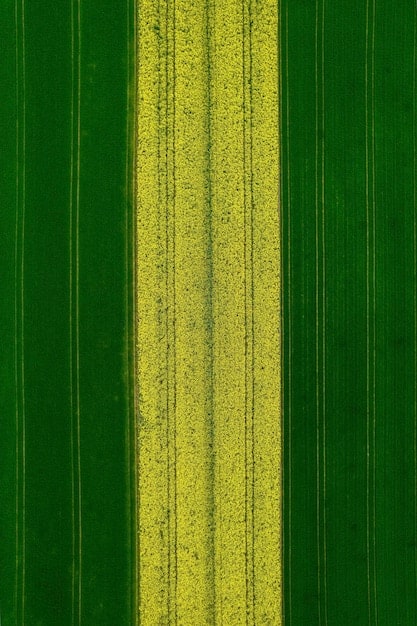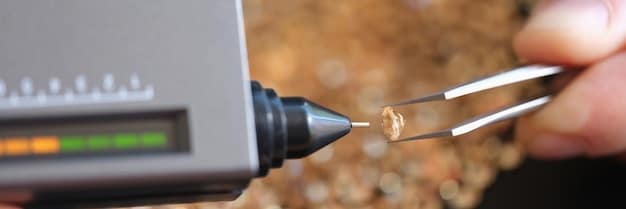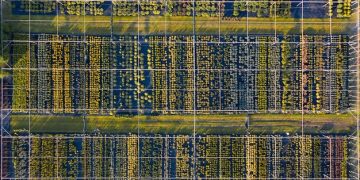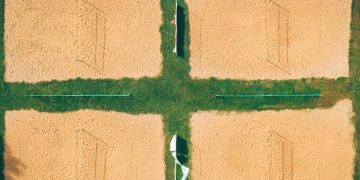Precision Planting: Boost Yields with Optimized Seed Placement

Precision planting optimizes seed placement and spacing, enhancing crop uniformity and potentially increasing yields by up to 10% through precise seed metering and placement technologies.
Are you looking to maximize your crop yields? Precision planting: Optimizing Seed Placement and Spacing for Increased Crop Uniformity and a 10% Yield Boost could be the answer. By focusing on exact seed placement and spacing, farmers can achieve greater efficiency and significant yield improvements.
What is Precision Planting and Why Does it Matter?
Precision planting is a modern agricultural technique centered around optimizing the placement of seeds in the soil. Unlike traditional planting methods, which often involve more generalized approaches, precision planting utilizes advanced technologies to ensure each seed is planted at the optimal depth, spacing, and soil contact.
The importance of precision planting stems from its potential to significantly enhance crop yields and overall farm efficiency. By accurately controlling seed placement, farmers can minimize seed wastage, promote uniform plant growth, and ultimately achieve higher productivity per acre.
Key Benefits of Precision Planting
Precision planting offers a range of benefits that contribute to improved agricultural outcomes. These advantages include:
- Enhanced Seed Placement Accuracy: Precision planters use sophisticated metering systems to ensure seeds are placed at the correct depth and spacing.
- Improved Crop Uniformity: Uniform plant stands lead to better resource utilization, as all plants compete equally for sunlight, water, and nutrients.
- Increased Yield Potential: By optimizing seed placement, precision planting can unlock a crop’s full yield potential.
- Reduced Input Costs: Precision planting minimizes seed wastage and can also reduce the need for fertilizers and pesticides due to improved plant health.
In conclusion, precision planting is a valuable tool for modern farmers seeking to maximize their productivity and profitability. Its focus on accuracy and optimization can lead to significant improvements in crop yields and resource efficiency.

The Technology Behind Precision Planting
Precision planting relies on a suite of advanced technologies to achieve its accuracy and efficiency. These technologies include sensors, GPS, and sophisticated control systems that work together to optimize seed placement.
Understanding the technology behind precision planting is crucial for farmers looking to implement this technique effectively. By leveraging these tools, farmers can make data-driven decisions and fine-tune their planting strategies for optimal results.
Components of Precision Planting Systems
A typical precision planting system consists of several key components:
- Seed Metering Units: These units accurately measure and dispense individual seeds at the desired rate.
- Row Units: Row units are responsible for creating the seed furrow, placing the seed, and closing the furrow.
- Sensors: Sensors monitor various parameters, such as soil moisture, seed depth, and spacing consistency.
- GPS and Guidance Systems: GPS technology enables precise field mapping and automated steering for accurate row placement.
With these sophisticated tools, farmers can ensure optimal seed placement, leading to improved crop establishment and higher yields. Precision planting systems empower growers to manage their fields with greater control and predictability.
Optimizing Seed Spacing for Maximum Yield
Seed spacing is a critical factor in determining crop yield. Precision planting allows farmers to fine-tune seed spacing to match the specific needs of the crop and the field conditions.
Optimal seed spacing ensures that each plant has adequate access to resources like sunlight, water, and nutrients, leading to uniform growth and maximum yield potential. By adjusting seed spacing, farmers can tailor their planting strategies to achieve the best possible outcomes.
Factors Influencing Seed Spacing
Several factors can influence the optimal seed spacing for a particular crop:
- Crop Type: Different crops have different spacing requirements based on their growth habits and resource needs.
- Soil Type: Soil fertility and water-holding capacity can influence the ideal spacing between plants.
- Climate: In drier climates, wider spacing may be necessary to ensure each plant has access to adequate moisture.
- Variety: Different varieties of the same crop may have varying spacing requirements.
By carefully considering these factors, farmers can use precision planting to optimize seed spacing and maximize their yields. Proper seed spacing promotes healthy plant growth and efficient resource utilization.

Achieving Crop Uniformity with Precision Planting
Crop uniformity is a key indicator of overall crop health and yield potential. Precision planting plays a crucial role in achieving crop uniformity by ensuring that all plants emerge and grow at a similar rate.
Uniform plant stands are better able to compete for resources and are less susceptible to pests and diseases. By promoting crop uniformity, precision planting can significantly enhance overall crop performance.
Benefits of Uniform Plant Stands
Uniform plant stands offer several advantages:
- Improved Resource Utilization: Uniform plants can more efficiently utilize sunlight, water, and nutrients, leading to higher yields.
- Reduced Pest and Disease Pressure: Uniform crops are less susceptible to pest and disease outbreaks.
- Easier Management: Uniform plant stands simplify crop management tasks, such as irrigation, fertilization, and harvesting.
Ultimately, precision planting’s ability to promote crop uniformity can lead to significant improvements in yield, quality, and overall farm profitability. Growers benefit from more predictable and consistent crop performance.
The Potential for a 10% Yield Boost
One of the most compelling benefits of precision planting is its potential to increase crop yields. Studies have shown that precision planting can lead to a yield boost of up to 10% compared to traditional planting methods.
This yield increase is primarily due to improved seed placement accuracy, optimized seed spacing, and enhanced crop uniformity. By addressing these key factors, precision planting unlocks the full yield potential of the crop.
Factors Contributing to Yield Increases
Several factors contribute to the yield increases observed with precision planting:
- Optimal Seed Depth: Precise seed depth ensures consistent emergence and early growth.
- Consistent Seed Spacing: Uniform spacing minimizes competition and promotes efficient resource utilization.
- Improved Seed-to-Soil Contact: Proper seed-to-soil contact enhances water uptake and nutrient absorption.
With its advanced technologies and precise control over planting parameters, precision planting offers a significant opportunity for farmers to improve their yields and profitability by as much as 10%. This makes it a worthwhile investment for forward-thinking growers.
Implementing Precision Planting on Your Farm
Implementing precision planting on your farm requires careful planning and investment in the right equipment and technology. However, the potential benefits in terms of increased yields and efficiency make it a worthwhile endeavor.
Farmers should start by assessing their current planting practices and identifying areas where precision planting could offer the greatest improvements. Consulting with precision agriculture experts can also be beneficial in developing a customized implementation plan.
Steps for Implementing Precision Planting
Here are some key steps to consider when implementing precision planting:
- Assess Your Needs: Evaluate your existing planting practices and identify areas for improvement.
- Select the Right Equipment: Choose a precision planting system that meets the specific needs of your crops and field conditions.
- Train Your Staff: Proper training is essential for operating and maintaining precision planting equipment effectively.
- Monitor and Adjust: Regularly monitor your planting performance and make adjustments as needed to optimize results.
By taking these steps, farmers can successfully implement precision planting and reap the rewards of improved yields and resource efficiency. Careful planning and execution are key to maximizing the benefits of precision planting technology.
| Key Point | Brief Description |
|---|---|
| 🌱 Optimized Seed Placement | Ensures each seed is placed at the ideal depth and spacing for maximum growth. |
| 🚜 Advanced Technology | Uses sensors, GPS, and control systems to enhance planting accuracy. |
| 📈 Yield Increase | Can potentially boost crop yields by up to 10% through optimized planting. |
| 🌿 Crop Uniformity | Promotes even plant growth which leads to better competition for resources. |
Frequently Asked Questions
Precision planting is an advanced agricultural technique that ensures seeds are placed at an optimal depth and spacing. It uses technology to enhance crop growth.
By precisely controlling seed placement, plants have equal access to sunlight, water, and nutrients, reducing competition and fostering healthy growth, thus higher yields.
Precision planting uses sophisticated tools like GPS, sensors, seed metering units and row units to implement accurate sowing to promote healthy plant growth.
Precision planting’s effective for various crops by optimizing plant density, and making it a versatile and beneficial method. Each crop species has it’s optimization methods.
The main economic benefits of precision planting are reduced seed wastage, and increased efficiency. It ensures optimal use of resources leading to greater profitability.
Conclusion
In conclusion, precision planting: Optimizing Seed Placement and Spacing for Increased Crop Uniformity and a 10% Yield Boost is a powerful tool for modern farmers. By focusing on accuracy and optimization, farmers can improve their crop yields, increase their profitability, and promote sustainable agricultural practices. As technology continues to advance, precision planting will likely become an even more essential part of farming operations.





